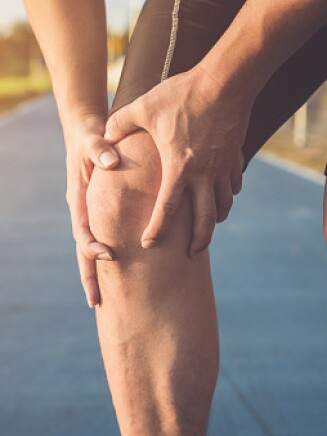A double hip replacement. A double knee replacement. Rib stabilization. Bariatric surgery.
While these procedures may all seem different on the surface, they do share one thing in common: Undergoing and recovering from any surgery requires a lot of mental and physical strength.
But what if we told you that the process can also uncover strengths you didn’t even know you had?
Just look at these three people, who are making the most of summer and embracing their athletic passions.
The bike racer who competes at 69
Kittie Weston-Knauer, 69, had double hip and double knee replacements
“I was always athletic: In my teens and 20s, I was an avid runner. But after my doctor diagnosed me with early-onset arthritis in both knees and hips at 28, I took up cycling. In my 40s, I was carting my son around to his bike races when I decided I didn’t want to simply watch him have fun, so I took it up myself—and loved it from the start.
I was also pretty good at it: I was 59 years old when I placed seventh in a bike racing championship.
About seven years ago, the pain in my knees and hips started to become more and more unbearable, and I feared I’d be sidelined by that pain. It was a struggle to walk. Even sleeping was uncomfortable. After multiple MRIs, it was clear I needed hip and knee replacements—on both sides.
It took me a while to find the right surgeon. Oftentimes, when I’d tell the various doctors I was interviewing that I was 63 and wanting to get back to bike racing as soon as possible, they’d tell me I was too old to race and needed to stop competing.
But that just wasn’t going to happen.
Four years ago I finally found a surgeon who was committed to helping me get back to racing, with as little downtime as possible. Together we decided that joint replacement was right for me. I had my first hip replacement, using the DePuy Synthes Corail® Total Hip System, in December of 2013, and my second hip replacement just two months later. The following December, I had both knees replaced within two weeks of each other using the DePuy Synthes Attune® Knee System.
I was on a mission to race in a national bike race championship just six months after my last knee surgery, so I took rehab very seriously. I asked my physical therapists for as many exercises as they’d give me, and recovered remarkably well. That June, I finished third at the nationals.
For years, I was afraid that having joint replacements would set me back. But, in the end, my surgeries actually fired me up even more. During rehab, I’d often ask myself: So you’re down, but are you out? And then I’d quickly answer: You’re never out. You can always come back in; it’s how you come back in that really matters. I promised myself I’d get back to the top of my game, and I did.
I just turned 69 and I’m training for another world championship. People often ask me why I still race. The simple answer is that I love it. I also race for the women who want to get into this sport who might look at me and say, ‘That woman can do it? I’m going to try, too.’ ”
Have knee pain?
You are now leaving jnj.com
The site you’re being redirected to is a branded pharmaceutical website. Please click below to continue to that site.
The Marathoner Who Once Weighed 320 Pounds
Tim Morgan, 53, had bariatric surgery
“Nearly 10 years ago, I woke up in the middle of the night feeling like there was an elephant sitting on my chest. I nudged my wife and told her I thought I was having a heart attack. She sleepily brushed me off, telling me it was probably just gas. Then, my left arm went numb, and I got nauseous.
We rushed to the hospital, where a doctor told me I was minutes from dying. My left coronary artery—what doctors call the ‘widowmaker’ because when it’s blocked, it often leads to massive heart attacks and sudden death—was 99% clogged. I was just 44 years old, and had to have four stents surgically implanted to reduce my risk of having a heart attack.
At the time, I didn’t feel like I was unhealthy. I weighed about 240 pounds, so I was overweight, but not obese. Yet I had high blood pressure, high triglycerides and type 2 diabetes. So I changed my eating habits, started working out and lost some weight.
Then, in 2010, my wife got pregnant with our son, Levi, and as her belly grew, mine did, too. I topped out at about 320 pounds, and felt miserable and uncomfortable all the time. My friends started calling me ‘Big Tim.’
So it was no big surprise when I started having high blood pressure issues again in late 2014, and my doctor ordered a stress test because he suspected another blockage in my heart. I’ll never forget hearing the cardiologist tell me that this time my right coronary artery was 99% blocked. He couldn’t understand how I hadn’t had another heart attack and how I was still alive. I thought to myself: OK, that was two times I should’ve died. I’ve got to do something.
I cleaned up my diet and started exercising. I got down to about 270 pounds, and then I hit a wall. No matter what I tried, I couldn’t seem to lose more weight. So in July 2015, I told my wife it was time for me to look into weight-loss surgery. In April 2016, I had a sleeve gastrectomy.
My surgery gave me another chance at life, and helped me realize that my life is worth something—I’m worth something. I’m committed to making the most of my time here.
It was the best decision of my life.
I’d seen a lot of people go through that surgery and knew that the ones who were successful at losing weight and keeping it off had goals; the ones who weren’t as successful thought they could lose weight just because they’d had the surgery. I was committed to never going back to where I was before, so I made some fitness goals immediately. I knew I wanted to start running, so I began by walking two miles two days after my surgery. By the end of that week, I was walking four miles. Two weeks after the surgery, my doc gave me the green light to start running.
That July, I ran my first 5K in 34 minutes and 54 seconds. I joined my gym’s running club, found a coach and started running six days a week. I set my sights on a half marathon, but my coach encouraged me to train for a full marathon. Before my surgery, I thought people who ran marathons were nuts. After my surgery, I found myself running for hours at a time.
I ran the Dallas marathon in December of last year—just eight months after my surgery. I’m training to run that marathon for a second time this year, and I’m also thinking about doing a triathlon. Levi is now 6 years old and has run a few 5Ks with me. He tells me, ‘Dad, I want to run marathons like you.’
My surgery gave me another chance at life, and helped me realize that my life is worth something—I’m worth something. I’m committed to making the most of my time here.”
Struggling to Shed Weight?
You are now leaving jnj.com
The site you’re being redirected to is a branded pharmaceutical website. Please click below to continue to that site.
The Triathlete Who Survived a Brain Injury
Todd Canfield, 46, had rib fixation and stabilization surgery
“I was on one of my usual group bike rides on a quiet country road in Santa Barbara, riding with about 30 other road cyclists, when a car tried to swerve around the pack. From what I’ve been told, he swerved around us so fast that he clipped the ditch, lost control of his car and hit me.
I don’t remember any of this because the impact threw me off my bike and directly into a tree.
I had a massive brain bleed—despite the fact that I was wearing my helmet. I also broke a number of bones, including my neck at C3 (the third vertebra), my right and left clavicles, and the scapula on my right side. I also broke every rib on my right side and broke three of those ribs in two places, which led to a punctured lung.
When you break that many ribs, they just kind of float in your chest, making breathing impossible. I was put on a ventilator, but since that wasn’t a long-term solution, my doctors decided to do a new surgery with the DePuy Synthes MatrixRIB™ Fixation System, which means they surgically placed small plates over my right rib cage to keep those ribs in place and allow my lungs to fully expand. As soon as they put those plates in, I could breathe again.
That accident happened four years ago. Due to my brain injury, I had to stay off my bike for a year because if I fell again and got another concussion, it would’ve been bad. So I started running. I was still in a lot of pain, but I ran out of sheer determination. Nobody was going to hit me, change my life and then keep me from getting back on my bike at some point.
A year after my accident, I finally got back on my bike. It was a little nerve-racking, for sure. If there are cars behind me, I still have this visceral reaction. But I still ride.
Before my accident, I never raced. Now I’m faster than ever. One reason is that I’m down about 30 pounds. When I got hit, I weighed 205 pounds. After six weeks of being on a feeding tube, I walked out of the hospital at 175 pounds, and I’ve hovered around that number ever since.
I also think I’m faster because my accident stoked my competitive spirit. I was always competitive. But after my accident, that took on a new meaning. I was angry—and running and bike racing has been a way to channel that anger.
At the end of the day, I wanted to prove to myself that I could get back to doing what I loved—and I did that.”










